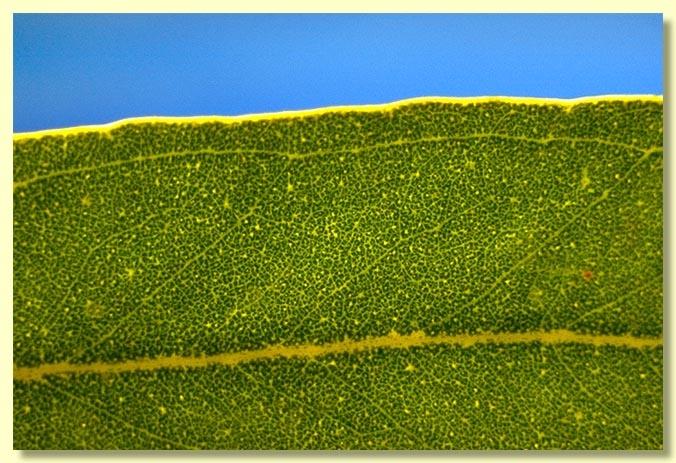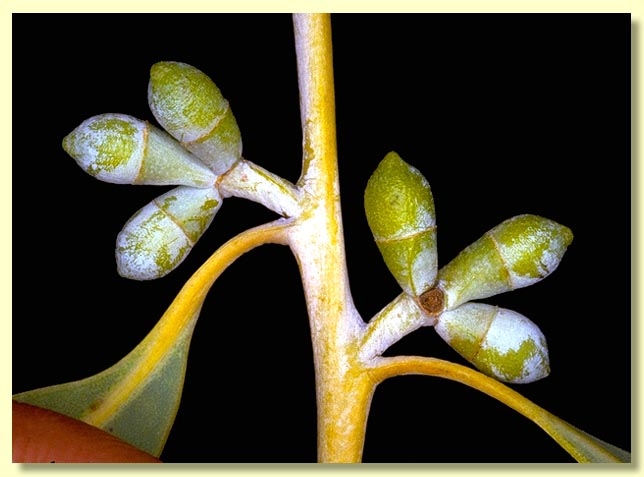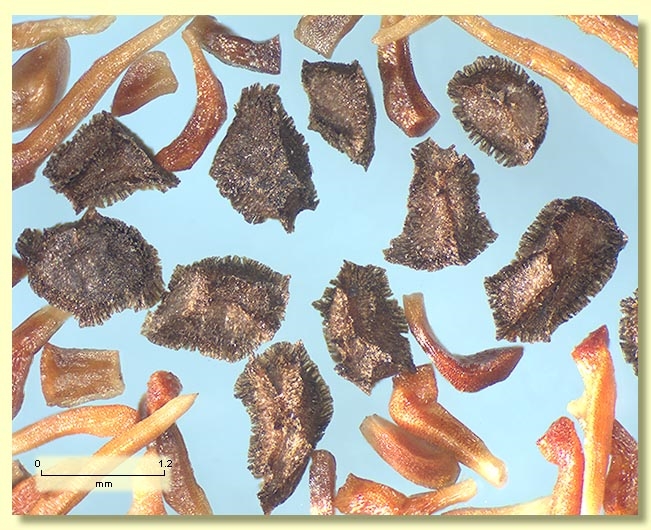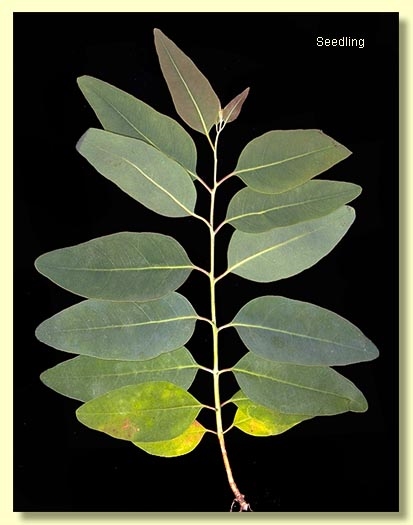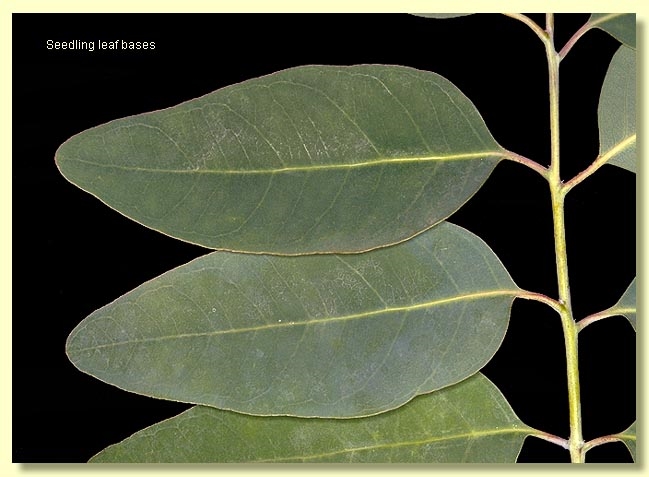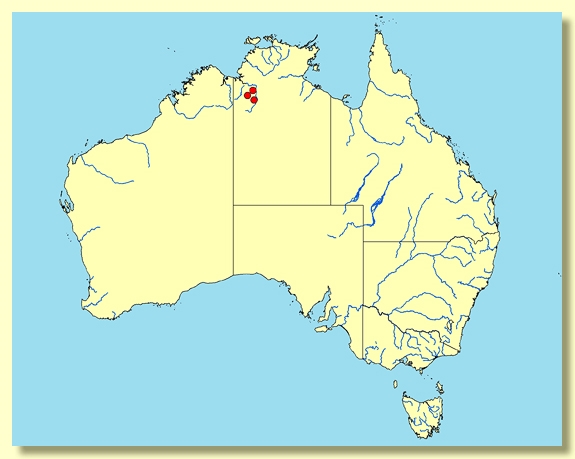Eucalyptus | Symphyomyrtus | Exsertaria | Subexsertae | Pyramidales
Euclid - Online edition
Eucalyptus gregoriensis
Eucalyptus gregoriensis N.G.Walsh & Albr., Muelleria 11: 41–44 (1998).
T: Northern Territory, Victoria River District, Gregory National Park, tributary of East Baines River, 50 km SW from Bullita outstation, N.G.Walsh 4547 and G.J.Jones, 17.iv.1996; holo: MEL; iso: DNA.
Small tree or mallee to c. 8 m tall, often of poor form or with semi-weeping habit. Forming a lignotuber.
Bark smooth and powdery throughout, new bark pale pink, maturing to white. Branchlets usually not glaucous, but occasionally glaucous.
Juvenile growth (coppice or field seedlings to 50 cm): stems square in cross-section; juvenile leaves petiolate, alternate, ovate to broadly lanceolate, 8–18 cm long, 4–9 cm wide, base rounded to tapering, dull grey-green to slightly glaucous.
Adult leaves alternate, petiole 0.8–3 cm; blade narrowly lanceolate to lanceolate, sometimes falcate 8–17(22) cm long, 1.2–3 cm wide, base tapering to the petiole, margin entire, apex pointed, concolorous, dull green to grey-green to blue-grey to rarely slightly glaucous, side-veins acute or at a wider angle than 45° to the midrib, reticulation very dense, intramarginal vein present, oil glands small, sparse and intersectional or obscure.
Inflorescence axillary unbranched, peduncles (0)0.2–0.4 cm long, buds per umbel 3, rarely 7, sessile to shortly pedicellate (pedicels 0–0.1 cm long). Mature buds obovoid to fusiform, 0.6–0.8 cm long, 0.3–0.4 cm wide, usually not glaucous, but rarely glaucous in some populations, scar present, operculum rounded to conical (0.3–0.4 cm long), hypanthium weakly 2-ridged, stamens irregularly flexed or with some outer stamens erect and the inner ones inflexed, anthers oblong, versatile, dorsifixed, dehiscing by longitudinal slits, style long and straight, rarely hooked beneath the operculum, stigma blunt, locules usually 4, the placentae each with 6 or more vertical rows of ovules. Flowers white.
Fruit sessile to shortly pedicellate (pedicels 0–0.1 cm long), cup-shaped to hemispherical, 0.4–0.5 cm long, 0.5–0.6(0.7) cm wide, usually not glaucous, rarely glaucous in some populations, disc raised, convex to annular, valves 4, strongly exserted.
Seeds dark brown to black, 1.2–2 mm long, ± obliquely pyramidal, dorsal surface shallowly reticulate, ventral surface ribbed, edge of seed sharply toothed, hilum terminal.
Cultivated seedlings (measured at ca node 10): cotyledons shallowly bilobed, stem square in cross-section, glaucous; leaves opposite for ca 5 to 6 nodes, then alternate, always petiolate, ovate to broadly lanceolate, 8–12 cm long, 3–5.5 cm wide, base rounded to tapering to the petiole, dull grey-green to slightly glaucous.
Flowering time unknown.
A small tree or mallee from the Gregory National Park and the Victoria River Downs region of the Northern Territory. At present, poorly collected and thus far only known from up high, along seasonal watercourses on the sandstone plateaus, cliffs and boulders of this area. Characterised by the smooth white powdery bark, the distinctly petiolate, concolorous, lanceolate adult leaves, the three-budded umbels and the relatively small, sessile buds and fruit, the fruit with a narrow disc and prominently exserted valves.
Eucalyptus gregoriensis belongs to a small group of species closely related to the red gums. This group is distinguished by having smooth powdery bark, adult leaves with dense to very dense reticulation and intersectional or absent oil glands, buds with incurved or erect stamens, fruit with a raised convex to annular disc and obliquely pyramidal, toothed seeds with a terminal hilum. Other members of this group are E. mooreana, E. herbertiana, E. cupularis, E. glomericassis and E. pantoleuca.
Within the subseries Pyramidales, E. gregoriensis is closest to E. cupularis and E. herbertiana. It differs from both these species by having shorter umbel peduncles, usually less than 0.5 cm long, and three-budded umbels (both E. cupularis and E. herbertiana have umbel peduncles longer than 0.5 cm and have seven–budded umbels). It is distinguished from E. glomericassis by having dull green to grey-green to rarely slightly glaucous adult leaves and a relatively narrow disc on the fruit (E. glomericassis with glossy green adult leaves and a broad disc). It is easily distinguished from the other two members of the group, i.e. E. mooreana and E. pantoleuca, by its adult leaf shape and position. E. gregoriensis has petiolate, lanceolate, alternate adult leaves, while E. mooreana has sessile, opposite, elliptical to ovate adult leaves and E. pantoleuca has petiolate, ± opposite, orbicular to deltoid adult leaves
Within its area of occurrence, E. brevifolia and E. confluens are the only other closely related white gums that may be confused with E. gregoriensis. They both can be distinguished by having fruit with a broad flat disc and valves that are near the rim or only slightly exserted (the fruit in E. gregoriensis has a disc that is annular and not broad and has prominently exserted valves). E. confluens can be further separated by having glossy adult leaves (always dull in E. gregoriensis).
E. camaldulensis var. obtusa, another smooth-barked gum with white or grey bark and distantly related to E. gregoriensis, does occur in the same area as E. gregoriensis. It can be easily separated on seed colour and shape. E. camaldulensis always has yellow, smooth, cuboid seed, while the seed from E. gregoriensis is dark brown to black, toothed and ± obliquely pyramidal. If seed is not available then the two can be separated on leaf venation, bud number and bud shape. E. camaldulensis has moderate to dense reticulation in the adult leaves, seven-budded umbels with peduncles much longer than 0.5 cm and, for this area, a beaked operculum (the bud shape in E. camaldulensis is variable). E. gregoriensis has dense to very dense reticulation, usually three-budded umbels with a peduncle 0.5 cm or less and buds with a rounded to bluntly acute operculum.
MORE ABOUT RED GUMS AND OTHER ASSOCIATED GROUPS
Eucalyptus gregoriensis: referring to Gregory National Park, the prime area of occurrence for this species. In the protologue, the authors also commemorate A.C. Gregory, who was the first European to explore this area in 1855–1856.



